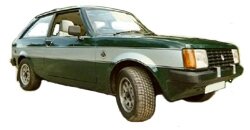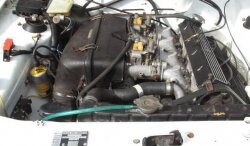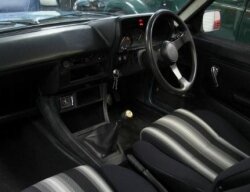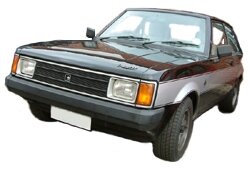Model Page
Lotus Talbot Sunbeam

|
Production Run: |
2,308 |
|---|---|
|
Production Date: |
1979 - 1981 |
|
Engine: |
2,172cc 16v DOHC |
|
Built: |
Linwood(UK) Hethel (UK) |
|
0-60: |
6.8 secs |
|
Max Speed: |
122mph |

The Lotus Talbot Sunbeam started off life as a Chrysler, in 1976 Chrysler UK was in a poor state financially. Chrysler had approached the Government believing that after the effective nationalization of British Leyland they should also receive state aid with Chrysler threatening to close down its UK operations should a grant not be forthcoming. The government agreed to the request and gave £55 million to the company to develop a new small car that would replace the Hillman Imp provided that the model would be designed in Chrysler’s UK facilities and manufactured at the Linwood factory in Scotland.

Lotus Talbot Sunbeam
With funds secured development start in 1976 under the codename Project R424, the styling was performed in house by Chrysler at their Whitley design Studio in Coventry under the stewardship of Roy Axe. Unfortunately, due to the plight of the parent company the car had to be built to a low budget and further restrictions such as the use of as many British components as possible hampered development. Therefore rather than use a front wheel drive setup as used successfully in other Chrysler organisations, the car had to utilise a rear wheel drive setup using the same platform (although shortened by around 3 inches) as the Hillman Avenger. The use of the Avenger chassis allowed the new car to use many components already in existence and allowed the car to be put into production at the Linwood works quickly and without the need to overhaul the production facilities.
In the mid 70’s Chrysler Competitions Manager Des O’Dell had been searching around for a car with which to mount a serious attempt at winning the Rally championship. Having seen the Vauxhall Chevette HS establish itself as a contender to the dominant Escort RS, he quickly identified the Sunbeam as having potential, but was unable to find an engine within the group that was suitable. Lotus had been supplying 2 litre engines to the recently defunct Jensen Healey; a deputy of his Wynne Mitchell contacted Lotus to supply engines and a deal was quickly signed.

Lotus Talbot Sunbeam Engine
Des O’Dell returned to Chrysler with two engines, the first being a 2 litre 16 valve slant four generating 155bhp and the second a modified unit producing around 230bhp. The engine in a lower state of tune was installed in an Avenger and used for testing and product evaluation by management, having been subsequently approved the engine was installed into the Sunbeam.
Two prototypes were built and raced competitively by Tony Pond, although the car was not particularly reliable, the car proved a success displaying good handling characteristics and being fast. Lotus then increased the displacement of the engine to 2.2 litres to extract more power whilst giving better reliability. The engine was of all alloy construction fitted with twin 45mm Dellorto Carburettors, a 16 valve twin cam cylinder head.
The car was developed with the assistance of Lotus, having already designed and manufactured the engine; the company developed the suspension and exhaust system for the unit. The Sunbeam Lotus used the majority of its components from the Avenger including the ZF gearbox, brakes, 4HA axle and wiring loom.
In 1978 Chrysler was in serious financial difficulties and was forced to sell its European arm to Peugeot. Peugeot needed to find a new name for their new division and found the Talbot brand that had last been used in 1959. Having proved itself, and despite the ongoing take over the go-ahead was given for production and the car was unveiled at the Geneva Motor show in 1979.

Lotus Talbot Sunbeam Interior
To enable the car to compete at international events 400 cars had to be produced to satisfy homologation with this being achieved on 1st April 1979. Production was not a particularly efficient affair. Each car was produced at the Linwood factory and built as a 1.6 GLS but fitted with the Lotus tuned stiffer springs and dampers, stiffer suspension mounts, a 10 % larger anti-roll bar, and stronger gearbox casings. These rolling chassis’s were then delivered to Lotus’s Hethel plant in Norfolk where the engine accompanied by a larger radiators and 5 speed ZF gearbox were fitted. The cars were then shipped to the Stoke Works in Coventry for final pre-delivery inspections.
Initially, the Lotus Sunbeam was only available in Embassy black with a smart Silver stripe running down the side, the car was finished off with smart Lotus Alloy wheels. The car looked subtle and understated, inside the car was trimmed in grey.
The car was generally well received but the car was in some quarters criticised for having wayward handling. The production cars generated approximately 150bhp with 0-60 being achieved in around 6.8, the car going on to hit the 100 mph barrier in 19.8 seconds, the car was capable of achieving around 22mpg.
In 1981, the car was revised slightly, being fitted with larger flush headlamps, a new grill, updated door mirrors and more importantly the car was fitted with a larger fuel tank thus increasing the range of the car. The engine received minor revisions that increased power and torque outputs by a small degree. The interior trim was replaced with a black and grey “Piccadilly/Candy Stripe” trim. The car was now available in Moonstone blue paintwork but customers could have black or silver side stripes added to the car – this was to be the only colour option for the 1982 model year.

Lotus Talbolt Sunbeam
With sales of the car slowing a limited edition Avon model was introduced. The Avon cars were available in Moonstone blue paintwork only, but included Talbot Dark Blue bands top and bottom and was fitted with a vinyl roof complete with sunroof. Yellow Lotus badges were fitted to each wing to distinguish the car from the lesser models. Interior wise the cars were re-trimmed with plush material including new carpets and better soundproofing.
It was intended that each Avon car was to be registered from DDU 1Y to DDU150Y, however a total of only 57 cars were converted and of these only 30 were registered DDU and these weren’t registered consecutively. The remaining 27 cars were sold registered as A and B registrations.
The car competed in international rally events between 1979 and 1982, wining the world championship for the Talbot team in 1981. The cars biggest achievement was at the 1980 British Rally where Henri Toivonen became the events youngest winner and the Lotus Sunbeams finished first, third and fourth. After the 1982 season the Talbot team was disbanded and most of the team transferred to Peugeot in Paris.
Production of the Lotus Talbot Sunbeam ended in 1981 as the Linwood plant in Scotland was closed after a round of rationalisation by the new owners Peugeot and production of the Sunbeam ceased.
The Facts
|
Engine: |
Lotus In-Line 4 Double Overhead Cam |
|---|---|
|
Capacity: |
2,172cc |
|
Valves: |
16 |
|
Compression Ratio: |
9.4:1 |
|
Fuel System: |
Twin 45mm Dellorto Carburettors |
|
Maximum Power: |
155bhp @ 5,750 rpm. |
|
Maximum Torque: |
149lb/ft @ 4,500 rpm. |
|
Transmission: |
Manual 5 speed. |
|
Top Gear: |
21.65mph per 1000 rpm. |
|
Brakes: |
Servo Assisted Solid Front Discs / Rear Drums |
|
Kerb Weight: |
960kg |
|
Max Speed: |
122 mph |
|
0-60: |
6.8 secs |





